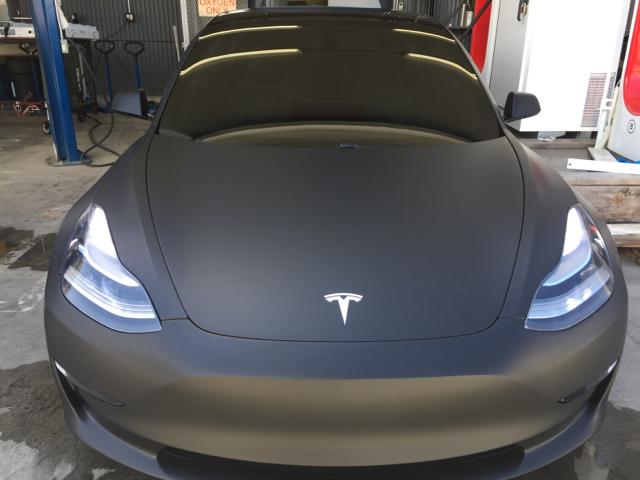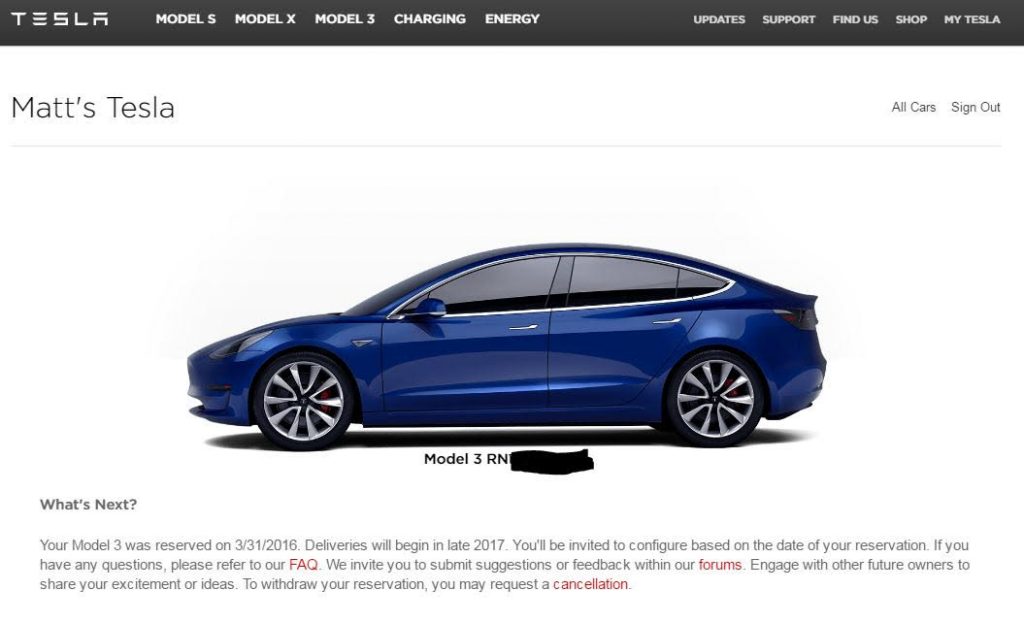News
Tesla updates ‘My Tesla’ page for Model 3 reservation holders; Suppliers question timeline
Tesla has sent its first update to Model 3 reservation holders. The updates tell customers they will be contacted by the company when it is time to configure their car. The update shows the Model 3 in blue for the first time.

Model 3 reservation holders may feel a tad closer to realizing their dreams of ownership knowing that Tesla has just updated their My Tesla page with an image along with minor details of the company’s much anticipated mass market electric vehicle. The update provides depositors that plunked down $1000 for their place in line to configure the Model 3 confirmation that the company will begin deliveries towards late next year. The page reads as follows:
“What’s Next?
Your Model 3 was reserved on <insert your date of reservation>. Deliveries will begin in late 2017. You’ll be invited to configure based on the date of your reservation. If you have any questions, please refer to our FAQ. We invite you to submit suggestions or feedback within our forums. Engage with other future owners to share your excitement or ideas. To withdraw your reservation, you may request a cancellation.”
Photo courtesy of Matt Simmons
The My Tesla page update shows the Model 3 in blue for the first time, but also provides a link to allow reservation holders to cancel their spot in line if they wish to do so.
In other Model 3 news, the press is reporting grumblings from various suppliers and industry observers about the accelerated production schedule for the Model 3 that Elon Musk announced two weeks ago.
Jeff Schuster of industry forecaster LMC Automotive said the goals were “implausible,” in part because Tesla’s battery factory in Reno, Nevada, was unfinished. Aluminum, lithium and other materials – already in short supply – “could be another limiting factor,” said Sam Fiorani of AutoForecast Solutions.
Other industry observers tell NBC News that getting a production line ready often takes 2 to 3 years. Chrysler is converting its Sterling Heights assembly plant to build more Ram 1500 pickup trucks. It wants to boost production to 300,000 vehicles a year — a 50% increase.
“FCA already has the talent and the money, and the underlying machinery is already installed in the plant,” said one longtime supply sales executive. “They’re aiming to be up and running in 2018, so they have two years – and suppliers are wondering if they’ll make that deadline.”
Ramping up to produce ten times as many cars as today in just 18 months seems a near impossibility to many experienced auto industry analysts. The company still is soliciting bids for parts and machinery, according to several industry sources. Automaking consultant Ron Harbour of Oliver Wyman said increasing production at the Fremont plant to 500,000 vehicles in 2018 would require more stamping, welding and assembly machinery that “could take up to 18 months to order and install.”
The fact that Tesla is doing this at a time when many other manufacturers are retooling factories to increase production places additional constraints on the company’s proposed timeline, a Detroit based supplier sales executive tells NBC. “I’d be really surprised if he can launch production by next July,” said Frank Faga, a Detroit-based auto manufacturing consultant. “But this is a guy who says he’s going to Mars. Who am I to say he can’t do this?”
Hat tip to Matt Simmons @Teslapittburgh; Source: NBC News

News
Tesla FSD fleet is nearing 7 billion total miles, including 2.5 billion city miles
As can be seen on Tesla’s official FSD webpage, vehicles equipped with the system have now navigated over 6.99 billion miles.

Tesla’s Full Self-Driving (Supervised) fleet is closing in on almost 7 billion total miles driven, as per data posted by the company on its official FSD webpage.
These figures hint at the massive scale of data fueling Tesla’s rapid FSD improvements, which have been quite notable as of late.
FSD mileage milestones
As can be seen on Tesla’s official FSD webpage, vehicles equipped with the system have now navigated over 6.99 billion miles. Tesla owner and avid FSD tester Whole Mars Catalog also shared a screenshot indicating that from the nearly 7 billion miles traveled by the FSD fleet, more than 2.5 billion miles were driven inside cities.
City miles are particularly valuable for complex urban scenarios like unprotected turns, pedestrian interactions, and traffic lights. This is also the difference-maker for FSD, as only complex solutions, such as Waymo’s self-driving taxis, operate similarly on inner-city streets. And even then, incidents such as the San Francisco blackouts have proven challenging for sensor-rich vehicles like Waymos.
Tesla’s data edge
Tesla has a number of advantages in the autonomous vehicle sector, one of which is the size of its fleet and the number of vehicles training FSD on real-world roads. Tesla’s nearly 7 billion FSD miles then allow the company to roll out updates that make its vehicles behave like they are being driven by experienced drivers, even if they are operating on their own.
So notable are Tesla’s improvements to FSD that NVIDIA Director of Robotics Jim Fan, after experiencing FSD v14, noted that the system is the first AI that passes what he described as a “Physical Turing Test.”
“Despite knowing exactly how robot learning works, I still find it magical watching the steering wheel turn by itself. First it feels surreal, next it becomes routine. Then, like the smartphone, taking it away actively hurts. This is how humanity gets rewired and glued to god-like technologies,” Fan wrote in a post on X.
News
Tesla starts showing how FSD will change lives in Europe
Local officials tested the system on narrow country roads and were impressed by FSD’s smooth, human-like driving, with some calling the service a game-changer for everyday life in areas that are far from urban centers.

Tesla has launched Europe’s first public shuttle service using Full Self-Driving (Supervised) in the rural Eifelkreis Bitburg-Prüm region of Germany, demonstrating how the technology can restore independence and mobility for people who struggle with limited transport options.
Local officials tested the system on narrow country roads and were impressed by FSD’s smooth, human-like driving, with some calling the service a game-changer for everyday life in areas that are far from urban centers.
Officials see real impact on rural residents
Arzfeld Mayor Johannes Kuhl and District Administrator Andreas Kruppert personally tested the Tesla shuttle service. This allowed them to see just how well FSD navigated winding lanes and rural roads confidently. Kruppert said, “Autonomous driving sounds like science fiction to many, but we simply see here that it works totally well in rural regions too.” Kuhl, for his part, also noted that FSD “feels like a very experienced driver.”
The pilot complements the area’s “Citizen Bus” program, which provides on-demand rides for elderly residents who can no longer drive themselves. Tesla Europe shared a video of a demonstration of the service, highlighting how FSD gives people their freedom back, even in places where public transport is not as prevalent.
What the Ministry for Economic Affairs and Transport says
Rhineland-Palatinate’s Minister Daniela Schmitt supported the project, praising the collaboration that made this “first of its kind in Europe” possible. As per the ministry, the rural rollout for the service shows FSD’s potential beyond major cities, and it delivers tangible benefits like grocery runs, doctor visits, and social connections for isolated residents.
“Reliable and flexible mobility is especially vital in rural areas. With the launch of a shuttle service using self-driving vehicles (FSD supervised) by Tesla in the Eifelkreis Bitburg-Prüm, an innovative pilot project is now getting underway that complements local community bus services. It is the first project of its kind in Europe.
“The result is a real gain for rural mobility: greater accessibility, more flexibility and tangible benefits for everyday life. A strong signal for innovation, cooperation and future-oriented mobility beyond urban centers,” the ministry wrote in a LinkedIn post.
News
Tesla China quietly posts Robotaxi-related job listing
Tesla China is currently seeking a Low Voltage Electrical Engineer to work on circuit board design for the company’s autonomous vehicles.

Tesla has posted a new job listing in Shanghai explicitly tied to its Robotaxi program, fueling speculation that the company is preparing to launch its dedicated autonomous ride-hailing service in China.
As noted in the listing, Tesla China is currently seeking a Low Voltage Electrical Engineer to work on circuit board design for the company’s autonomous vehicles.
Robotaxi-specific role
The listing, which was shared on social media platform X by industry watcher @tslaming, suggested that Tesla China is looking to fill the role urgently. The job listing itself specifically mentions that the person hired for the role will be working on the Low Voltage Hardware team, which would design the circuit boards that would serve as the nervous system of the Robotaxi.
Key tasks for the role, as indicated in the job listing, include collaboration with PCB layout, firmware, mechanical, program management, and validation teams, among other responsibilities. The role is based in Shanghai.
China Robotaxi launch
China represents a massive potential market for robotaxis, with its dense urban centers and supportive policies in select cities. Tesla has limited permission to roll out FSD in the country, though despite this, its vehicles have been hailed as among the best in the market when it comes to autonomous features. So far, at least, it appears that China supports Tesla’s FSD and Robotaxi rollout.
This was hinted at in November, when Tesla brought the Cybercab to the 8th China International Import Expo (CIIE) in Shanghai, marking the first time that the autonomous two-seater was brought to the Asia-Pacific region. The vehicle, despite not having a release date in China, received a significant amount of interest among the event’s attendees.









